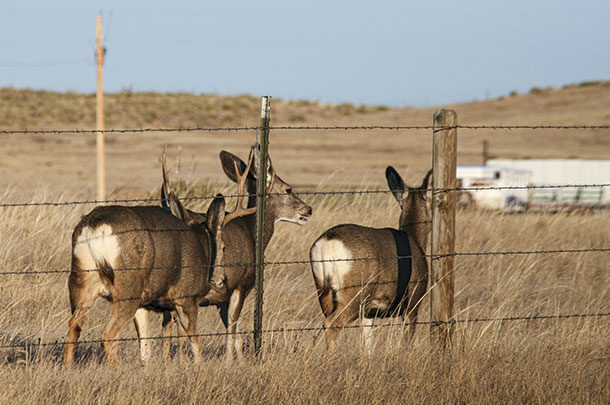This disease, due to its zoonotic and highly contagious nature, is carefully monitored by state veterinarians and the USDA with the goal of eventual eradication. In addition to the human health risks, TB has the potential to severely impair herd performance, limit exportability and marketability, and pose a fatality risk. In some cases of infected herds, depopulation may be mandated by the state vet and the USDA.
Bovine TB is caused by the bacteria Mycobacterium bovis, a different strain than the Mycobacterium tuberculosis that causes the disease in humans. Though M. bovis primarily affects cattle, it does have the ability to be transferred to humans and other mammals. This disease causes infection in not only the lungs and their associated lymph nodes but also spreads to multiple other small organs throughout the body.
What’s the risk?
While TB outbreaks can and do occur throughout the country, Northern states, especially certain parts of Michigan and the Dakotas, are especially at risk.
“In areas where a wildlife reservoir exists for bovine TB, such as what is called Michigan’s Modified Accredited Zone (MAZ), cattle can be exposed when infected deer have access to their feed and water sources, stored feed and pasture areas,” Dr. Nancy Barr, assistant state veterinarian of Michigan, says. “Michigan farms in this area and some surrounding counties use wildlife risk mitigation principles to help reduce their risk and protect their herds.”
Dr. Russ Daly, extension veterinarian at South Dakota State University, elaborates, “It’s important to understand that, while deer and similar wildlife species can carry tuberculosis and pass it to cattle, it’s only in certain geographic areas that tuberculosis is present in these wildlife populations.”
In the Accredited Free Zone (AFZ) of Michigan and other states, the risk of exposure is from other infected domestic cattle as opposed to wildlife. In the MAZ, where the risk of infection from deer is present, TB monitoring is generally carried out through surveillance testing. This will typically catch infected herds before cattle are clinically ill. In fact, all cattle and bison herds in the MAZ must be tested annually. In the AFZ, the primary strategy for surveillance is under slaughter via USDA-FSIS inspections.
At this time, North Dakota has not identified any TB in wildlife. However, the disease is still something cattlemen in the state need to be vigilant of. Dr. Susan Keller, state veterinarian for North Dakota, says this includes having an overall understanding of the disease and consulting with their veterinarian. The state’s animal health website also provides up-to-date information from the USDA.
“Know what the risks are, and don’t assume that because a state or country’s status is ‘free for TB,’ that all animals are absolutely free of TB,” she says. “We know that is not always the case.”
Surveillance is also carried out by watching imported cattle. Canadian imports are only required to be tested if they originate from provinces that have not been declared TB-free by the Canadian Food Inspection Agency. According to Daly, this is because Canada has fewer TB cases than the U.S. due to their smaller herd size. However, all Mexican cattle coming in are required to undergo testing.
“These steps help keep the disease out of the U.S., but we also have to be aware that our testing is less than perfect,” Daly further stresses. “A young animal that’s just infected might still test negative yet harbor the disease.”
The program by the USDA-APHIS to eradicate bovine tuberculosis began in 1917; at that time it was estimated 5% of the national cattle herd was infected. According to USDA data, in 2018 only 0.005% of the national herd was found infected. Over the course of the past 20 years, that breaks down to an average of only five to 10 identified herds each year. (Though USDA-APHIS notes some years where there’s been as few as one – and as many as 13 some years.)
The impact
Although occurrences in both beef and dairy herds are fairly rare in the U.S., TB awareness is something all in the industry should be aware of. When it does rear its head, TB needs to be dealt with swiftly and properly.
TB can affect the health of individual animals and cause restrictions of movement to be imposed on animals and herds, but it is not a food safety issue, Keller notes. Carcasses undergo Food Safety and Inspection Service (FSIS) inspection to ensure the meat is from a healthy animal. Pasteurized products are also safe for consumption. The Center for Disease Control and World Health Organization are putting more focus on TB education and awareness efforts again.
“To me, that is hopeful because ignorance is not bliss when it comes to a disease that was so prevalent at one time we had to start a national eradication program to address it,” she says. “Maybe the public and producers just need to be reminded how devastating the disease is to animals and humans to maintain support and resources needed for disease eradication, not just disease control.”
The North Dakota Department of Health Division of Disease Control notes there is also a greater emphasis to treat all persons diagnosed with TB infection (LTBI). The North Dakota TB Program, along with the CDC, encourages treatment of latent TB infection, as it is essential to controlling and eliminating TB in the U.S. because it substantially reduces the risk that latent TB infection will progress to TB disease. Up to 13 million people in the U.S. have latent TB infection and, without treatment, they are at risk for developing TB disease in the future – but with treatment, this risk is greatly reduced.
“The real outcome of TB today is the regulatory response. Infected herds are subject to many months or years of animal testing and, in some cases, depopulation of the herd. This is all to limit any further spread of the disease,” says Daly. “It’s really tough because of the insidious nature of the disease and the lack of perfect tests. We really rely on the action of our state and federal vets to keep the eradication programs working.”
He notes proper animal identification and record-keeping are critical to being effective in eradication. This is especially important whenever an investigation does take place so the source can be identified and dealt with quickly.
In higher-risk areas, some precautions are also necessary to prevent cross-contamination from livestock.
“In Michigan’s MAZ, we have wildlife risk mitigation programs to reduce risk from contact with infected deer,” says Barr.
She notes that even in the free zone, herds should practice a biosecurity program that works for their operation and management style. “These include purchasing healthy animals, minimizing commingling of animals if possible, keeping animals that show clinical signs of disease separated from healthy animals, and maintaining a clean environment and providing good nutrition for your animals,” she says.
When a herd is tested positive for TB (either from a carcass that’s traced back to a particular operation or live animals found in the MAZ’s regular testing), decisions are made jointly. The state veterinarian, owner and USDA-APHIS must decide to depopulate or continue a strict management with a test-and-remove protocol in place. In both situations, USDA-APHIS will provide indemnity funds for either depopulation or the removal of cull animals. Typically, multiple tests will take place in a herd over the course of approximately five years so they can “test out” and no longer be considered a risk and free to commerce freely again.
Conscious efforts by producers and veterinarians have shown a great impact on TB in the bovine population. While it is unlikely most producers will find their herds at risk of this specific disease, the established protocol and risks can help establish management practices which protects both private herds and the national population. ![]()
PHOTO: Bovine tuberculosis is a serious but rare and carefully monitored disease. Beef producers and animal health professionals can work together in eradicating it through surveillance, monitoring risks, management of infected herds and biosecurity protocols. Photo by Paul Marchant.
Jaclyn Krymowski is a freelancer based in Ohio.












